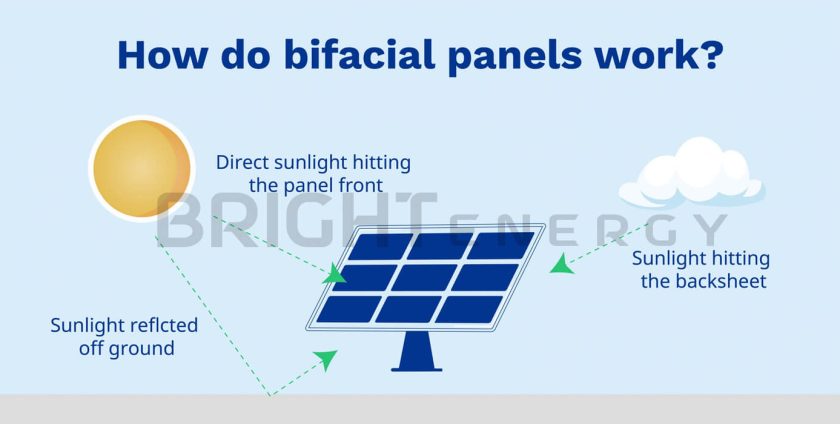
As the technology is evolving, the solar power system and its components are also evolving for betterment. The solar panels are also being upgraded into better solar panels for higher productivity. One such type of solar panels is called “Bifacial solar panels”. Bifacial solar panels represent a remarkable innovation in the field of solar energy technology.
The previous technology of solar panels worked on the technology that it could only convert sunlight to DC current if its PV side is facing the sunlight. But Bifacial Solar panels, as the name suggests, can convert sunlight to DC current from both sides.
What Are Bifacial Solar Panels?
Bifacial panels have the unique ability to capture sunlight on both their front and rear sides. These panels are enabled to harness sunlight from multiple angles. This innovative and unique design promises of better productivity and higher efficiency of the solar power systems as compared to traditional monofacial panels.
How Bifacial Solar Panels Work:
The key feature of bifacial solar panels is their transparent back sheet or glass back surface. Unlike traditional solar panels with an opaque back sheet, bifacial panels use a transparent material that allows sunlight to pass through and reach the solar cells on the rear side.
Just like monofacial panels, bifacial solar panels capture sunlight on their front surface. It means that bifacial panels can harness direct sunlight from above, as well as, reflected sunlight from the ground, surrounding surfaces, or even snow, effectively capturing energy from multiple angles.
When sunlight directly hits the front side, the solar cells absorb the photons and convert them into direct current (DC) electricity through the photovoltaic effect. This process is the same as that in traditional solar panels.
What sets bifacial panels apart is their ability to capture sunlight on the rear side. Sunlight that passes through the transparent back sheet reaches the solar cells on the back surface of the panel. These rear cells absorb the photons and convert them into additional DC electricity.
Bifacial panels can also capture reflected sunlight, known as the albedo effect. Light can reflect off various surfaces including the ground, snow, or nearby buildings. Bifacial panels are designed to capture this reflected light, further increasing their energy production. It is particularly advantageous in environments with reflective surfaces, such as snowy landscapes or near bodies of water.
Bifacial solar panels can be mounted in various configurations to optimize their performance. They can be installed on elevated structures, tracking systems, or vertical surfaces, allowing them to capture sunlight from different angles throughout the day. Tracking systems, in particular, allow the panels to follow the sun’s movement, ensuring maximum exposure to sunlight.
Advantages of Bifacial Solar Panels:
- Increased Energy Yield:
Bifacial panels can generate more electricity than traditional monofacial panels because they utilize both direct and reflected sunlight. It can lead to a significant increase in energy yield, especially in locations with reflective surfaces like snow, water, or light-colored rooftops.
According to the different models, Bifacial solar panels can generate up to 30% more current.
- Versatility in Installation:
Bifacial panels can be installed in various configurations, such as elevated structures, tracking systems, or vertical installations. This flexibility allows for creative and space-efficient designs, making them suitable for a wide range of applications.
- Environmental Benefits:
By generating more energy from the same amount of space, bifacial panels contribute to a higher energy output per unit area. This increased efficiency can lead to a reduction in land use for solar farms, preserving natural habitats and landscapes.
- Durability:
Bifacial panels are designed with durable materials to withstand varying weather conditions, ensuring a long operational lifespan. This durability translates into a reliable and sustainable energy source over the panel’s lifetime.
- Financial Returns:
While bifacial panels may have a higher upfront cost compared to traditional panels. They are also costlier as in Pakistan mostly traditional and monofacial solar panels are in use due to being less expensive. The increased energy production of bifacial panels can result in a quicker return on investment and higher overall financial returns, making them an attractive option for solar projects.
Considerations and Challenges:
While bifacial solar panels offer numerous advantages, there are factors to consider, such as:
- Installation Design:
Maximizing the benefits of bifacial panels requires careful consideration of the installation design, including the surface they are installed on, the surrounding environment, and the potential for shading.
The panels should also be installed at least 4 meters above the ground so that they can also get reflective sunlight from underneath.
- Modeling and Simulation:
Proper modeling and simulation tools are essential for accurately predicting the energy yield of bifacial panels based on specific site conditions. Precise simulations help optimize the panel layout and orientation for optimal performance.
- Cleaning and Maintenance:
Bifacial panels require periodic cleaning to ensure both sides remain free of dust and debris. Regular maintenance is crucial for maximizing energy capture efficiency.
Bifacial solar panels represent a significant advancement in solar technology, offering the potential to enhance energy production and efficiency across various applications.
As research and development continue to refine their design and performance, bifacial panels are poised to play a significant role in the transition to a more sustainable and energy-efficient future. Contact Bright Energy if you are interest in Bifacial Solar panels and want to know more about them.
Related Cool Links:
- By: Admin
- Tags: Bifacial Solar Panel Price in Pakistan, Bifacial Solar Panels, Bifacial Solar Panels in Pakistan, What Are Bifacial Solar Panels?
- 0 comment

Leave a Reply